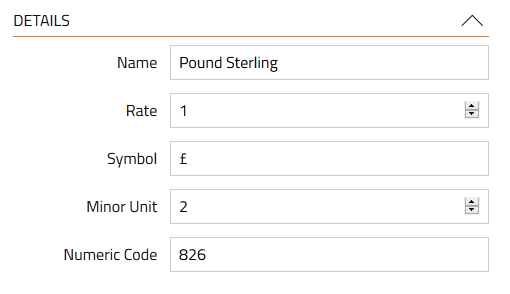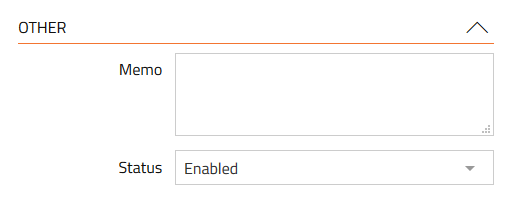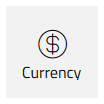Currencies
An explanation of and detailed look at the fields and dependencies in the Currency data source, and how to create a new record.
![]()
The “Currency” record is used to hold rates of exchange to allow pricing conversion during any billing process ![]() . The file is pre-populated but the data can be edited anytime.
. The file is pre-populated but the data can be edited anytime.
Some features are dependent upon your select plan for your account.
Indicates a feature is only available in Standard or above.
Indicates a feature is only available in Enterprise.
Currency is included in Solarvista Lite ![]() for reference cost and sale prices only.
for reference cost and sale prices only.

Where Currency Records are Used
The following files refer to Tax Rates records so if you plan to use any of these, setting up the records in this file will be important or even critical:
Data Sources:
- Customers
- Suppliers
- Products
- Agreements

- Price Book

- Actions
- Recurring Work

- Invoices

Work Items:
- Generic Job
- Field Repair
- Internal Repair
- Depot Repair
- Field Maintenance
- Internal Maintenance
- Survey
- Field Task
- Internal Task
- Help Desk Call
Pre-requisite Files for Currency Records
When setting up Currency records, it is recommended to review the other data files that may need to be referred to by each record. These are the files that you may need to setup in advance:
None.
Field Descriptions for Currency
The ID section holds the unique ID and names:

Reference - holds the unique ID for the record (most records in Solarvista have one of these). It cannot contain any spaces or non-standard characters. Once the record is saved, it is not possible to edit it afterwards. In most default situations, the Reference is automatically set using a counter sequence, however, you can setup your own if you prefer.
The Details section holds the detail of the Currency:

Name - the formal name of the currency.
Rate – the conversion rate to the Base Currency (held in Settings) to be used for conversions in billing.
Minor Unit – the number of minor units to use.
Numeric Code – the ISO numeric code for the currency.
Symbol – the character symbol for the currency e.g. £ $ etc.
The Other section holds status:

Memo – free text notes for miscellaneous use.
Status – defines the status of the record as follows:
- Disabled – is not active. The record will not appear for selection in other parts of the system.
- Enabled – is active. The record will appear for selection in other parts of the system.
Creating a New Currency Record
To create a new Currency record:
- Click on the “Plus” button.

A menu will appear. - Within the “Data Sources” section, find “Currency”.

- Click on “Currency”.
- A new “empty” Office/Depot record will appear.
- Populate all fields as you require.
- Click on the “Create” button.

- You may need to refresh the page to see the new record in a view.

Editing a Currency Record
To edit a Currency record:
- From the main menu, select Currencies.

The default view for Currencies will open. - Click on the Quick Filter button.

- Enter criteria for the Currency record you are looking for and click Apply button.

- The view will update. Find the record you are wanting to edit.
- Click anywhere on the row that shows the record. The record will open.
- You can edit any field that allows editing (some could be set to read only).
- Click on “Save” button to save changes.

Deleting a Currency Record
To delete a Currency record.
- From the main menu, select Currencies. The default view for Currencies will open.
- Click on the Quick Filter button.

- Enter criteria for the Currency record you are looking for and click Apply button.

- The view will update. Find the record you are wanting to delete.
- On the left side of the view is a column containing checkboxes.
- Check the box of the record you want to delete.
- Click the “Delete” button on the top right.

A slide in dialog will appear prompting you to confirm the delete, by typing in the word “DELETE” again. - To confirm, click the “Delete” button and the record (or records) will be deleted.

Note: You cannot delete a Currency record that is already in use with a Work Item i.e. Jobs. You can delete Currency records referred to only by other Data Sources however this will leave those records without an associated to a valid Currency record. If this happens by accident, you can manually recreate the record ensuring the Reference is identical. You can also change the status of the record to prevent it appearing on screen in future whilst maintaining historical integrity.
Customising or Adding New Fields
Solarvista™ is built upon and with a no-code application platform that allows you to edit fields (or remove them in some cases) as well as add your own fields. These new fields (or edited characteristics of existing fields) automatically become available within the web portal and the mobile apps. For more information, refer to the Customising section.
Importing Cause Data in Bulk using Import Tool
If you have a lot of Cause information to enter, you may prefer to upload this using the Import Tool that’s built into Solarvista. The Import Tool enables Cause records to be created from “CSV” text files. CSV files can be created from a wide range of popular applications including Microsoft Excel. For more information on importing data into Solarvista, please refer to the article here.
Continue the Setting Up Data series with Categories.